Whether you know them as Oranda goldfish or red caps, odds are you’ve considered adding these fancy goldfish to your collection.
Their distinct appearance sets them apart from common goldfish, brightening aquariums and ponds alike.
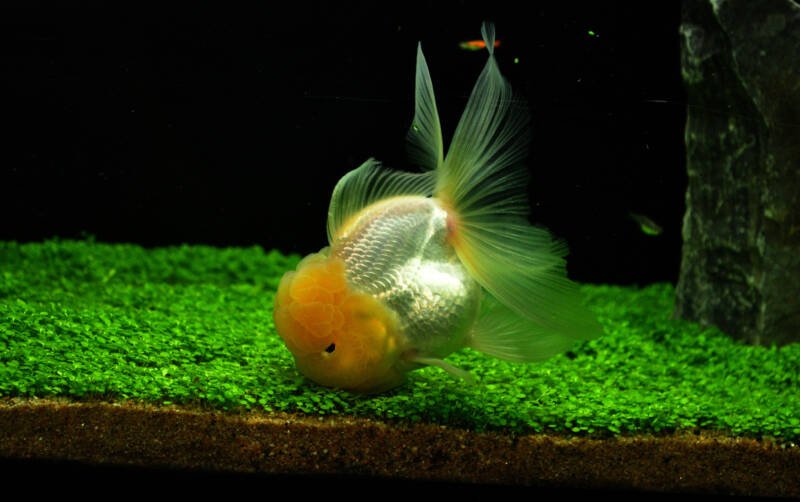
Unlike common goldfish, Orandas (Carassius auratus) sport egg-shaped bodies. A lot of times, their width matches their length.
Throw in the paired fins, and you get a dramatic fish that drifts through the water with grace. And, of course, how can you overlook the wen?
The wen is the name for the crown or overgrown cap distinctive to Orandas. It starts developing when the fish reaches three-months-old, and it continues to grow throughout their lives.
While providing a unique look, it also offers a challenge to aquarists caring for these fish.
And the difficulties don’t end there. Common goldfish tolerate “pollution” of their water with wastes to some extent. Orandas? Not in the slightest.
Even though both share the same hardy ancestor, Orandas and novice aquarists don’t combine well together.
If you’re prepared to tackle exacting care demands – and nurture the needs of that stunning wen – then Orandas make a rewarding addition to any freshwater collection.
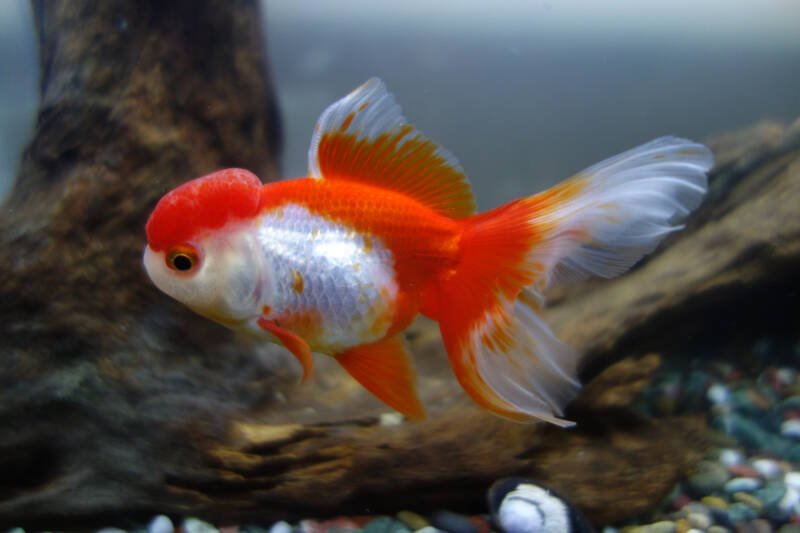
Who knows – you may even enjoy the luck, wealth, and power they represent in most Asian cultures!
At a Glance
| Min tank size: | 30 gal (120 l) |
| School Size: | five (recommended) |
| Temperature: | 65-72°F (18-22°C) |
| Lifespan: | up to 15 years |
| Size: | 8-9 inches (20-23 cm) |
| pH: | 5.0-8.0 |
| Hardness: | 4-20 dH |
| Ammonia: | 0 ppm |
| Nitrite: | < 0.2 ppm |
| Nitrate: | < 50 ppm |
In this article
In the “Wild”
As a selectively-bred variety of goldfish, you won’t find Oranda goldfish in the wild.
The design of their bodies and flowing, paired fins make them exceptionally slow swimmers. It’s a poor adaptation for existence in any natural environment.
However, all goldfish – common or fancy – trace their ancestry back to the Prussian carp (Carassius gibelio). This hardy native to the Siberian region frequented slow-moving and stagnant waters, feeding on a little bit of everything.
In the 15th century, China began experimenting with cross-breeding goldfish. The first Orandas appeared around that time.
They have the distinction of one of the oldest fancy goldfish. Now they share the spotlight with over 125 different varieties!
Orandas set themselves apart with their round shape, paired fins, wen, and their fantastic tails.
The caudal fin doubles, too, creating four sweeping points that trail through the water. You can find three different shapes: a broad tail, a fantail, and a ribbon tail.
Some people confuse the Oranda goldfish with the Lionhead.
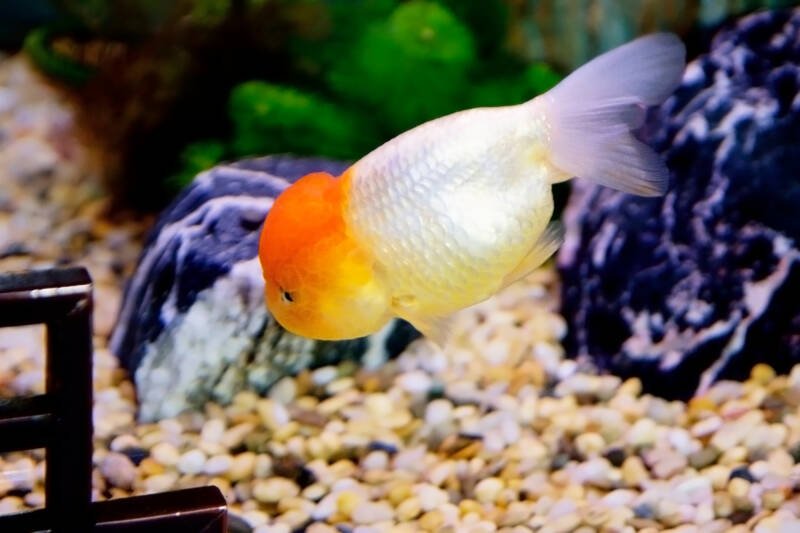
However, Lionheads lack a dorsal fin (the only non-paired fin on the Oranda). They also have a larger “hump” to their back and a more pronounced wen.
Tank – or Pond – Dependent
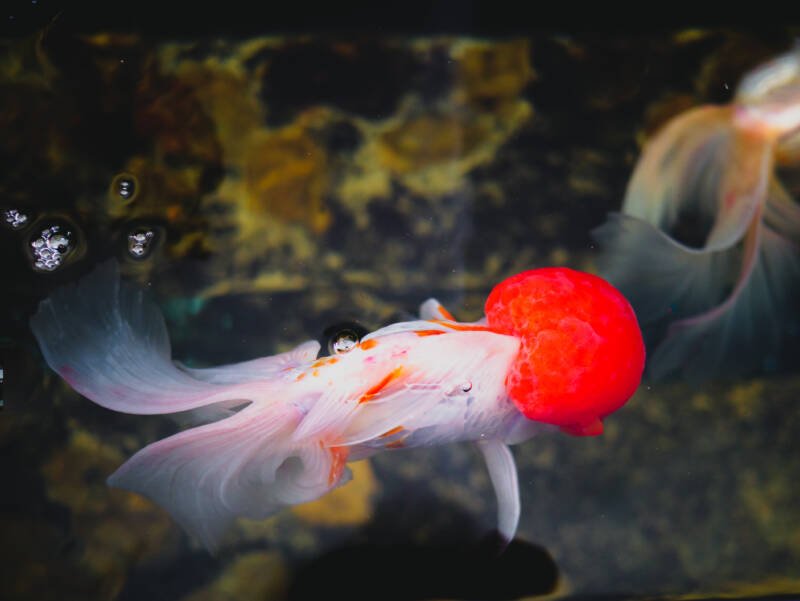
As with most goldfish species, Orandas grow to fit the size of their enclosure.
When kept in a PROPER tank, you’ll see your Oranda reach 7 inches (18 cm) in length. However, an average of 8-9 inches (20-23 cm) isn’t out of the ordinary.
Of course, the majority of an Oranda goldfish’s length comes from their magnificent tail.
The caudal fin accounts for TWO-THIRDS of the fish! So your Oranda may appear smaller than anticipated, depending on whether the tail’s extended or not.
And if you’re keeping your Orandas in a sub-standard living space, you’ll cut them short.
A tiny bowl or tank of 10 gallons (38 l) is MUCH too small. Your Oranda will suffer from stress and health issues, as well as ending up shorter than average.
If you aim higher, you stand a better chance of seeing more impressive sizes.
The current record for an Oranda goldfish is an impressive 15 inches (38 cm) long! The fish lives in Hong Kong, and his name is Bruce.
Lifespan
Despite the delicate appearance of the Oranda goldfish, they live for a surprisingly long time.
You can see your Orandas last up to 15 years – with careful management, of course. Their lifespan correlates directly with the care they receive.
So if you keep them under cramped conditions (such as a minuscule 10-gallon/38 l tank), fail to maintain healthy water conditions, or toss any-old food in at mealtimes, odds are your Orandas will perish early.
At the other end of the spectrum, considering a pond rather than a tank has distinct advantages.
Aquarists that keep Orandas in large ponds often see their fish living up to TWENTY years. It’s all in how you keep up with your fish management.
Popular Color Varieties
1. Black Orandas

Black Orandas come in a rich midnight hue. Surprisingly, the cap usually presents in a lighter shade than the remainder of the body.
You still get a dramatic appearance for your fish, though. Some also retain the original flecks of orange.
2. Blue Orandas
Blue Orandas may show up under the name Seibungyo or Seibun.
The blue colors range from the lighter end of the spectrum to almost indigo, with everything in between.
You’ll also get calico versions, with splashes of orange, white, and black.
3. Red Caps

Red Caps are the most notorious Oranda version. The wen comes in a vibrant crimson color that stands out against a white body.
These Orandas have the smallest caps, too. They’re the most popular of all of the varieties, despite their lack of unique colors.
Behavior
Oranda goldfish aren’t the fastest swimmers in the colorful fish department, with sweeping fins and a less-than-streamlined shape.
However, they DO remain active throughout the day. It’s just a lava lamp level of activity.
They’re not shy, either. As with other goldfish varieties, they prefer to observe the world around them for anything interesting.
You won’t see them pestering other fish in the tank or pond, either. They retain a peaceful demeanor in their explorations.
And while Orandas aren’t schooling fish, they’d much rather keep company with others of their kind.
Fancy goldfish or not, a single Oranda quickly grows despondent. A group of at least five keeps everyone satisfied, even if they won’t bunch together.
Orandas explore every level of a tank, even digging into the substrate.
But you may notice one barely moving in the lower regions from time to time. Odds are your Oranda has fallen asleep.
They lack eyelids, so it’s often difficult to tell. But the lack of movement’s a big key.

Tank Setup
The larger the space, the healthier the environment you’ll provide for your Oranda goldfish.
At a minimum, never go smaller than 30 gallons (120 l). And that’s for ONE fish.
For each additional Oranda, add 10 gallons (40 l). So 55 gallons (220 l) holds three Orandas.

Unhappily, goldfish produce a TON of waste – even the fancy version. You want to invest in a quality filter rated for the size of tank you settle on.
Clean water conditions will go a long way to keeping your Orandas happy and healthy.
Due to their structure, Orandas aren’t strong swimmers. As such, they appreciate the most oxygenated waters you can provide.
You may not do the trick with your filter’s outflow alone. Consider adding air stones to boost the oxygen levels.
Many aquarists opt for ponds instead of aquariums. Orandas handle pond-living without too much trouble – so long as you invest in a reliable heater.
They aren’t tropical species, but you need to keep them comfortable during the winter seasons.
Water Conditions
Unlike common goldfish, Orandas have a sensitivity to temperature fluctuations.
They’d prefer the water to stay as close to the middle of the 65-72F (18-22C) range as possible. To prevent accidents, make sure you have a thermometer in your tank or pond.
The goldfish ancestor might have been hardy, but Oranda goldfish have hundreds of years spent in captive conditions. As such, they have narrow acceptances for water conditions. They’ll tolerate a pH range of 5.0-8.0, but the neutral 7.0 works best.
As far as water softness goes, you’ll want to stick to the softer end.
A range of 5-20 dH works, but stability is critical. If you’re struggling to keep an even reading, you may find your Orandas succumbing to stress and illness.
And despite a reputation as “anything goes” fish, Oranda goldfish WON’T tolerate fluctuations in ammonia, nitrite, or nitrate.
If your ammonia sneaks above 0 ppm, it can prove fatal. Stay on top of your weekly water changes of 25% to prevent problems.
Decorating the Oranda Tank

While you want your Orandas to look good in their environment, decoration needs to prioritize safety.
As gorgeous as these fancy goldfish might be, they don’t have the best design. You need to think through your plans carefully.
Orandas enjoy digging in the substrate. You don’t want gravel that may scrape or cut into their wen, though. Soft sands offer the best choice.
You’ll want to vacuum it regularly. If bacteria accumulates from uneaten food, digging may expose the pathogens.
Planted tanks look best, but you need to think through plant options. You don’t want to crowd the swimming area.
Remember, Orandas aren’t the best swimmers, and they ARE large fish. It’s a careful balance.
You also need to review the types of plants. Plastic plants may have sharp edges that can catch on Oranda fins, tearing them and inviting infection or fin rot.
Live plants with delicate leaves may break when your Orandas scatter sand everywhere. The best compromises may be:
- Elodea
- Vallisneria.
Oranda Goldfish in Communities

While you’ll have to juggle a massive aquarium, there’s nothing wrong with a single species aquarium.
Orandas come in different color varieties, and they tolerate each other beautifully. However, they also integrate into communities without a problem.
Tank Mates
Ideally, you want to find tank mates of a similar size and disposition.
Orandas can’t swim fast enough to compete for food with quicker fish, and they may starve. And small fish may end up accidentally eaten.
Your best bet is to consider some of these like-minded fish:
Incompatible Species
Due to the long, flowing nature of their double fins, you want to skip adding known fin-nippers to your community. You’ll end up stressing – and injuring – your Orandas.
Aggressive fish won’t do any favors, either. So skip the following tank mates:
And while it’s tempting to add some invertebrates for “texture,” skip freshwater snails.
Orandas consider these mollusks a delicious snack. In no time, they’ll clear out the tank, leaving you with no snails. (After all, the snails are about the Orandas’ speed)
Food and Diet
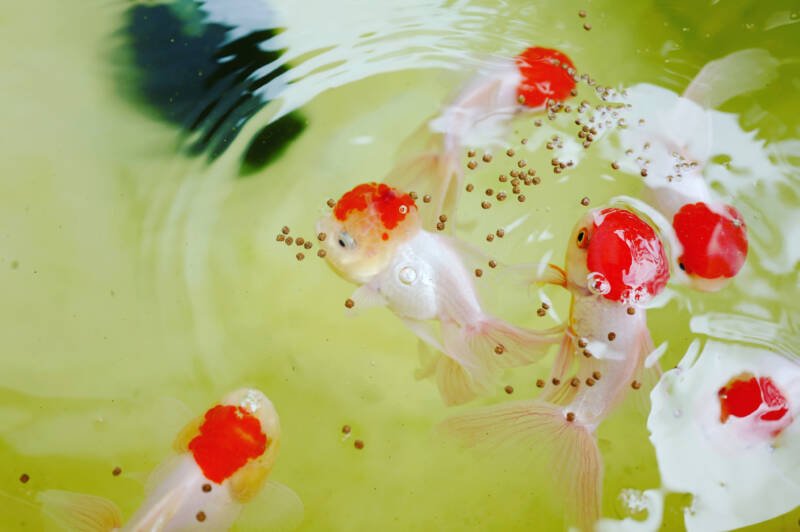
As omnivores, Oranda goldfish aren’t difficult to plan menus for. However, if you don’t watch the amounts you feed, you can cause problems.
The proper food portion is 3% of the fish’s size – ONCE a day. Any more and your fish will develop digestive problems. Or get FAT.
Orandas need high-quality protein sources. And you want to vary the protein to preserve the color of your chosen variety. If you do, the color will stand out brighter. The most popular protein sources include:
- Bloodworms
- Brine shrimp
- Daphnia
- Tubifex worms.
You can also work in vegetables to the rotation. Spinach and lettuce are packed full of nutrients AND help boost your Orandas colors.
Blanch the greens first. Then you can chop them into smaller pieces or float the veggies on the surface.
Breeding Your Oranda Goldfish: Group Activity
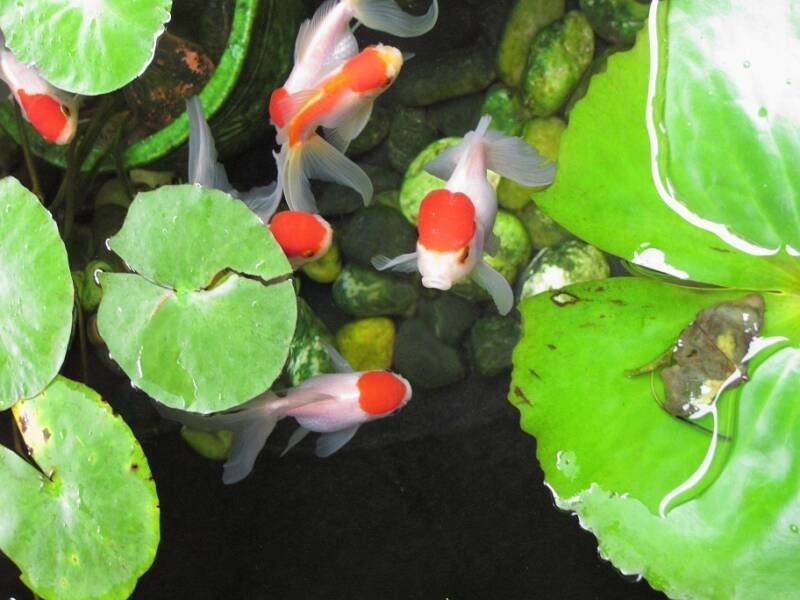
If you maintain a pair or group in your pond or aquarium, odds are you’ll end up with Oranda fry.
They’re not a problematic goldfish species to breed. You’ll need to do some preparation work, and you’ll want a separate breeding tank for success, but complicated? Nope.
Male or Female?
Oranda goldfish aren’t the easiest to sex. The differences tend to the subtle side, especially outside of the spawning season. Your best bet is to look at all of the fish in your school at once. You’ll start picking out individual differences that way.
Underneath the caudal fin, you’ll find the vent. In female Orandas, the vent is rounder and more pronounced.
They also have thinner, narrow pectoral fins. And when spawning season comes around, they’re wider when viewed from above.
In contrast, males have thicker pectoral fins. They also develop small, white bumps along the gill cover. These are known as breeding tubercles.
Of course, they only show up during the spawning season. But if you see them and notice a thinner profile, you know you have a male.
How Many Eggs?
If you can manage it, Oranda goldfish will spawn in groups of up to FIVE. Of course, that’s a pretty big aquarium to manage.
You want the breeding tank to resemble their usual aquarium, with the addition of either a spawning mop or fine-leaved plants.
Condition your spawners (all of them) with live foods for two weeks before shifting them to the breeding tank.
You’ll see their colors intensify, letting you know they’re ready. They’ll spawn in the early hours of the day. You’ll see the fish chase each other around the tank.
Each female can lay up to ONE THOUSAND eggs! It takes several hours, and the eggs hatch in the mop or on the plants’ leaves.
Remove the adults when they finish to prevent them from cannibalizing the eggs.
Eggs take anywhere from two to seven days to hatch. (Have some patience)
The fry need infusoria once they appear. You’ll need them to grow larger before you try to introduce them to baby brine shrimp.
Health and Diseases
Oranda goldfish come from hardy stock, but if you don’t stay on top of their water quality? You’ll see them come down with illness quickly. Everything revolves around the health of their living conditions.
Ich in Orandas comes down to stress. As pH and temperature bounce around, your Orandas become stressed, which gives the parasite a foothold. And once it gets established, it has all of those lovely folds in the wen to explore and infiltrate. Not a good thing.
And, unfortunately, the wen itself can turn into a nightmare.
For most Oranda goldfish, the growth of the cap stays manageable. For others, it drops down over their eyes. Unable to see, they can’t find food and start to starve.
While the wen doesn’t have blood vessels or nerve infiltration, cutting is NOT recommended, except by a professional.
You could inadvertently cause damage. There ARE medications available to restrict the wen’s growth, instead. Talk to your fish store manager.
Oranda Goldfish: Are They for You?
Most pet stores offer Oranda goldfish at an average size of 4 inches (10 cm).
You’ll pay anywhere between $35-$40. They’re not the cheapest goldfish out there, but considering how beautiful they look? They’re worth the investment.
You aren’t stuck to “gold,” either. Courtesy of the continued selective breeding process, Orandas come in several popular color varieties.
They all run about the same in cost. If you combine them, though, you’ll get a beautiful display in your aquarium.
The Most Popular Fancy Goldfish
If you want flowing fins and outstanding features, you can’t go wrong with Oranda goldfish.
These beautiful fancy goldfish represent luck and wealth in many Asian cultures. Of course, you may need both to cope with their demanding care needs!
Do you have Orandas? Are they in an aquarium or a pond?
What’s the most impressive length your Orandas have reached?
Let us know your questions and stories here!